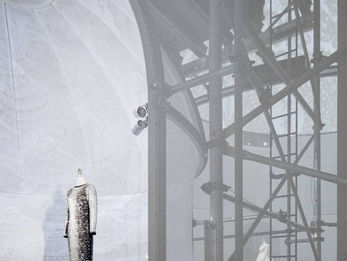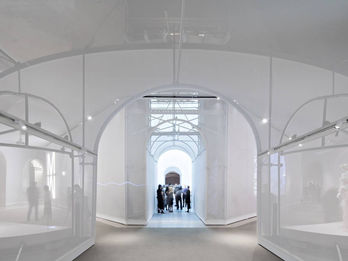2018 MCHAP

Manus x Machina: Fashion in an Age of Technology
OMA New York
New York, NY, USA
May 2016
AUTOR PRINCIPAL
OMA New York
AUTOR CONTRIBUYENTE
ARUP (Engineering) Dot Dash (Lighting) 3-Legged Dog (Media) Newmat (Membrane) UBS (Scaffolding) CW Keller (Dome)
CLIENTE
The Costume Institute at the Metropolitan Museum of Art
FOTÓGRAFO
Naho Kubota Brett Beyer Cassandra Warner and Jeremy Floto Albert Vecerka
OBJETIVO
We inserted a white, translucent volume into the existing brick and stone corridors of the Lehman Wing, softening its hard geometries. Echoing the sectional relationship of a central clerestory and perimeter naves, the resulting ghost cathedral resonates with the language of the adjacent Medieval Art gallery. A raised platform built across the double height atrium provides a continuous circulation and an additional 2,300 square foot central gallery – an unprecedented intervention in the Lehman Wing. Upon arrival, this domed clerestory orients visitor’s with Karl Lagerfeld’s Chanel wedding dress that embodies the exhibition’s theme. Details of the 20-foot train’s baroque pattern are projected on the dome’s scrim, recalling the Sistine Chapel. Four chapel-style poches provide areas to focus on case studies of different techniques. The high-performance, perforated membrane of the ghost cathedral offers the tensile flexibility required for the dome geometries as well as varying degrees of transparency. When lit from the front, the scrim appears opaque enough to function as a projection backdrop for garment details. Lit from behind, the scrim appears transparent, exposing a sense of the Lehman Wing’s existing material palette and language. The unexpected spatial depth of the scrim allows for visual connections to the wedding dress from all quadrants of the Lehman Wing, while also revealing silhouettes of the temporary scaffolding framework housed within. As an integrated system for lighting, signage and projection, the scrim seamlessly serves multiple curation needs that would otherwise rely on overpowering media screens.
CONTEXTO
The Metropolitan Museum of Art’s Costume Institute Spring 2016 exhibition, Manus x Machina: Fashion in an Age of Technology, explores how designers are reconciling the handmade and the machine-made in the creation of haute couture and avant-garde ready-to-wear. The collection entailed over 170 garments, diverse in designers, techniques and details. While fashion exhibitions, especially those focused on an aspect of technology, are typically saturated with screens digital displays. Manus x Machina required a more integrated environment for the diverse range of garments. The goal was to create a neutral environment that would encourage visitors to focus on the details of each garment in a contemplative setting. The exhibition was presented in the Robert Lehman Wing, a double-height octagonal addition on the museum’s central axis constructed in 1975. In order to preserve access to the permanent galleries, the exhibition space is located in the Lehman Wing’s central atrium and corridors. While beautiful in materiality and language, the usually neglected atrium space posed a number of unique environmental challenges for the exhibition: excessive daylighting unconducive to textile exhibition, split levels with no connective circulation, a corridor condition lacking dedicated display walls and an eclectic material palette.
ACTUACIÓN











